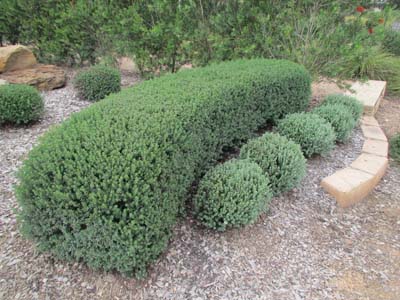
Aussie Box is a great medium sized Hedge, and Grey Box is for smaller hedges. They are both very drought tolerant.
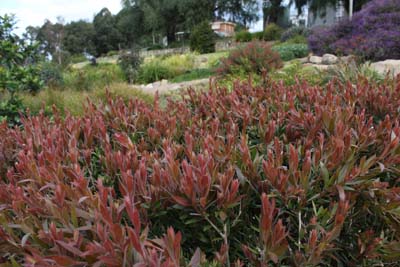
Red Alert is a more drought tolerant native alternative to Photinia.
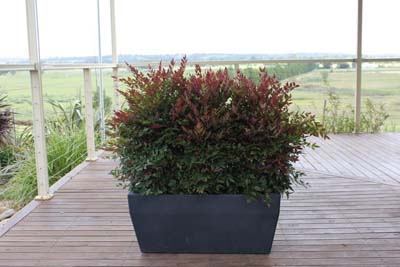
Obsession makes a great small hedge for driveways, paths and gardens.
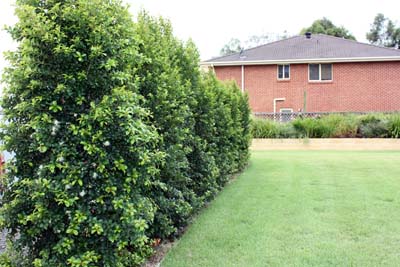
If you need a narrow hedge in shade or full Sun, Pinnacle is the best Lilly Pilly for the job.
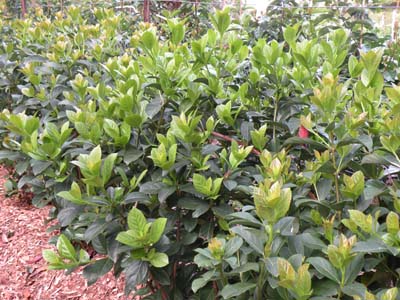
With increased Density and a smaller leaf, Dense Fence makes a great quick establishing hedge.
Hedges and screens in gardens create privacy or screen out an unwanted view. But their uses don't stop there; they can also be used to block out unwanted winds or perhaps the heat of the western sun, or they may be used to divide up the internal spaces of the garden into separate areas generally known as garden rooms.
They have been grown since before there were gardens. The earliest hedges protected agricultural lands and confined stock. These practical uses were combined with the decorative when hedges were used to encompass and divide gardens.
Hedges are natural companions to boundaries, but can also be used along a driveway or side passage, within the garden, flanking paths or beside a house or deck. Hedges can be deep, narrow or a combination of several rows of plants of successive heights known as stepped hedges. Tree-sized hedges are usually planted to block out prevailing winds and are referred to as windbreaks.
Although most hedges are thought of as being clipped and formal in appearance, they can be shaped, topiarised or allowed to grow in a loose informal way that respects the natural shape of the plant.
Qualities of a hedge
While just about any plant could possibly be planted as a hedge, the best plants for hedges have a list of desirable qualities to help them do their job well. Top of the list is to be evergreen, so the hedge can do its job all year round. Deciduous plants can be grown as hedges but, in winter when they lose their leaves, they become a see-through network of branches rather than a solid green wall.
Plants that suit hedges also need to respond well to regular clipping with new growth, must maintain dense growth from the tip of the plant to ground level and look good.
Types of hedging plants
If you think about hedge, your mind may conjour up an image of crisp box hedges around a rose garden, or perhaps a dark green conifer hedge that blocks out the neighbours or a busy road.
Traditional hedging plants such as box and cupressus are just the tip of the iceberg. There are many evergreen plants that can be grown as a garden hedge or screen. By understanding how you want your hedge to grow, you can choose a plant variety that exactly suits the role of the hedge and the growing conditions in your garden. Some of the features to use to assess a shrub or tree's suitability as a hedge plant include its colour (for example does it have colourful foliage, seasonal colour from new growth, or does it produce seasonal flowers), its growth rate, ease of pruning and its size (both height and width).
As well, plants selected for hedging need to be long-lived, resistant to pests and diseases and compatible with the climate, soil and aspect where the hedge is to grow. Plants that grow well as hedges come from climate zones around the world, so there is a huge choice to suit any climate or growing condition. There are also native hedging plants including selections of bottlebrush, westringia and lillypilly all of which perform well around Australia.Selecting for uniformity
However, one of the most important features to examine when selecting a plant to grow in a hedge is whether it has uniformity of growth. That is, it grows evenly in every direction and that each plant in the hedge has the same growth rate.
Not only does this create an attractive hedge, it also simplifies maintenance. Named cultivars are clones from a single plant so generally have uniform characteristic that mean they produce a better more homogeneous hedge than one planted from seed-grown plants.
Hedges by height
As most hedges need to be a certain height to fulfill their role in an individual garden, the easiest way to look at hedging plants is to group them according to their optimum growth heights.
Certainly larger growing plants can be trimmed to any size, but keeping a large plant small requires more maintenance than selecting one that naturally reaches the desired height and then slows its growth rate. For example a plant that only grows to around 3m is the variety to choose where that's the size hedge that's needed. Here is a selection of reliable hedging plants according to their height. All are evergreen, adaptable to a wide range of soil and climatic conditions and are amenable to pruning.
3m and above
Tall hedges that grow higher than 3m may need a ladder or trestle for pruning. They are best pruned with a heavy-duty pruner such as a petrol-powered pruner and planted around 1-3m apart depending on the width of the variety selected.
PINNACLE™ Syzygium australe 'AATS' PBR. A very narrow growing native tree that provides sculptured design for tight planting spaces. It makes an excellent tall hedge, needing less pruning to stay narrow.
Checklist
Dimensions: 6-10m high x 1-1.5m wide. Can be pruned down to 2m.
Foliage: Glossy green foliage.
Flowers: White duster flowers from November to December.
Where it works: Queensland, NSW, Victoria, South Australia, Western Australia and ACT (if protected from frosts). It is frost and heat tolerant.
Soil and aspect: Suits well drained, moist soils. Takes full sun to shade.
SUBLIME™ Acmena smithii 'DOW30' PBR. This mid-sized tree has dense foliage to the ground, making it ideal as a hedging or screening tree. It is extremely Psyllid resistant.
Checklist
Dimensions: 5m high x 2-3m wide.
Foliage: Green foliage with lush, lime green new growth.
Flowers: White fluffy flowers in summer.
Where it works: Queensland, NSW, Victoria, South Australia, Western Australia and ACT. It is frost and heat tolerant.
Soil and aspect: Suits well drained, moist soils. Takes full sun to shade.
SWEEPER® Waterhousea floribunda 'DOW20' PBR. A heavily weeping form of Waterhousea, ideal as a dense screen or hedge. It is a highly Myrtle Rust resistant tree (see Ozbreed's website for research).
Checklist
Dimensions: 10m high x 5-8m wide.
Foliage: Green, heavily weeping rippled leaf.
Flowers: Large clusters of white flowers in summer.
Where it works: Queensland, NSW, Victoria, South Australia, Western Australia and ACT (if protected from frosts). Tolerates cold and drought.
Soil and aspect: Suited to well drained to heavy clay loams. Takes full sun to part shade. Avoid hot or dry exposed inland regions.
2m-3m high
Medium hedges that only grow 2m-3m in height are easily maintained from the ground with pruning equipment. They can be pruned with an electric, battery or petrol-powered pruner or even hand shears if the hedge is not too long. Plant 1m part.
DENSE FENCE™ Viburnum odoratissimum 'VOC1' PBR. A Sweet Viburnum with finer leaves, higher density and shorter inter-nodes. It is highly suited as a privacy screen.
Checklist
Dimensions: 3.5m high x 2m wide.
Foliage: Green leaves with reddish growth in autumn and winter.
Flowers: White flowers in spring.
Where it works: Queensland, NSW, Victoria, Tasmania, South Australia and Western Australia. Tolerates minor to moderate frost once established.
Soil and aspect: Tolerant of most soil types and conditions, however, it prefers a sunny to partly shaded position with well-drained soil.
RED ALERT™ Callistemon viminalis 'KPS38' PBR. This is a compact Bottlebrush hedge with red new growth, making it a native alternative to exotic Photinia. It needs less pruning to establish as a hedge than Photinia. Simply prune to shape 1-3 times a year after red new growth.
Checklist
Dimensions: 2-2.4m high x 1.5-2m wide unpruned. 500mm-2m high x 400mm-1.5m wide pruned.
Foliage: Red new growth in autumn and spring.
Flowers: Rarely, if ever, flowers.
Where it works: Queensland, NSW, ACT, Victoria, Tasmania, South Australia and Western Australia. Tolerates frost and drought.
Soil and aspect: Suits most soil types and tolerates full sun to part shade.
RED HEAD™ Acmena smithii 'BWNRED' PBR. An attractive large shrub/small tree with deep green foliage and red new growth.
Checklist
Dimensions: 6m high x 2m wide.
Foliage: Glossy, rounded, deep green foliage. New growth flushes red to deep claret then changes to chocolate before hardening off to dark green.
Flowers: Clusters of small white flowers from October to December.
Where it works: Queensland, NSW, Victoria, South Australia, Western Australia and ACT (if protected from frosts). Tolerates cold and drought.
Soil and aspect: This Acmena suits well drained to heavy clay soils. Takes full sun to part shade.
SLIM™ Callistemon viminalis 'CV01' PBR. Perfect for tight planting areas, this Callistemon has a uniquely narrow growth habit. It has been tested down to -6 degrees Celsius with no leaf burn, which is excellent for a Bottlebrush. It is also highly Myrtle Rust resistant (see Ozbreed's website for research).
Checklist
Dimensions: 3m high x 1.3m wide.
Foliage: Fine, green foliage.
Flowers: Classic red Bottlebrush flowers in spring, summer and autumn.
Where it works: Queensland, NSW, ACT, Victoria, Tasmania, South Australia and Western Australia. Tolerates frost and drought.
Soil and aspect: Suits most soil types. Takes full sun to part shade.
1m-2m high
Small hedges that are maintained at around 1m-2m can be pruned with any type of powered pruner or by hand pruners such as shears. They should be spaced 50-70cm apart.
AUTUMN ROYALTY™ Rhododendron hybrid 'CONLEC' PBR. Autumn Royalty™ Rhododendron is a super heat tough, lace bug resistant Encore Azalea. Its most interesting feature is its masses of fuchsia flowers that repeat bloom in spring, summer and autumn.
Checklist
Dimensions: 1.25m high x 1.25m wide.
Foliage: Broad, green leaves.
Flowers: Fuschia flowers that repeat bloom in spring, summer and autumn.
Where it works: Queensland, NSW, ACT, Victoria, Tasmania, South Australia and Western Australia. Tolerates frost and moderate drought.
Soil and aspect: Prefers well drained soils. Takes full sun to part shade.
ENCORE AZALEAS. This range of Azaleas boast beautiful repeat flowering in spring, summer and autumn. The Azalea's in the range are heat and drought tolerant, with some of the plants being lace bug resistant.
NARINGA™ Westringia 'WES01' PBR. Naringa™ Westringia is the best hedging Westringia available for medium to tall hedges. It is very fast establishing and is a tidier form with much less pruning than other Westringias. Naringa™ Westringia needs pruning about half as much as other Westringias, and in a natural setting, probably not at all.
Checklist
Dimensions: 1m high x 60cm wide pruned; 2.2m high x 1.5m wide unpruned.
Foliage: Fine, green leaves.
Flowers: Small mauve coloured flowers in spring.
Where it works: NSW, ACT, Victoria, Tasmania, South Australia, Western Australia and South East Queensland (not suited to northern QLD). Tolerates cold and drought.
Soil and aspect: Suits sandy to well drained clay soils, avoid wet feet and depressed planting areas. Takes full sun to part shade.
Under 1m high
Low hedges that are maintained below 1m can be pruned with any type of powered pruner or by hand pruners such as shears. They can be planted around 30cm apart.
Ozbreed AUSSIE BOX® Westringia 'WES02' PBR. This Westringia can be pruned into a box hedge or left in its natural ball shape whilst staying tidy and compact. It is a great alternative to exotic box plants as it has faster establishment and requires less water. Simply prune to shape 1-3 times a year after flowering.
Checklist
Dimensions: 40-60cm high x 40-60cm wide pruned. 70-95cm high x 70-95cm wide unpruned.
Foliage: Dense green narrow leaves.
Flowers: Small mauve coloured flowers in spring/summer.
Where it works: NSW, ACT, Victoria, Tasmania, South Australia, Western Australia and South East Queensland (not suited to northern QLD). Tolerates frost and drought. Soil and aspect: Suits most soil types, but prefers free draining soils. Avoid wet feet and depressed planting areas. Takes full sun to light shade.
GREEN JOHN™ Callistemon viminalis 'LJ23' PBR. This is a highly Myrtle Rust resistant Callistemon with lovely light green new growth. It is denser and faster growing than Little John.
Checklist
Dimensions: 60cm-1m high x 60cm wide.
Foliage: Dense green narrow leaves with light green new growth.
Flowers: Red flowers from September to November.
Where it works: Queensland, NSW, ACT, Victoria, Tasmania, South Australia and Western Australia. It is cold and drought tolerant.
Soil and aspect: Suits sandy to well drained soils. Takes full sun to part shade.
GREY BOX™ Westringia fruticosa 'WES03' PBR. A drought tolerant native that also thrives beside the sea, Grey Box™ Westringia has grey green leaves and white flowers. It is dense and naturally rounded in its growth. It naturally forms a rounded hedge to 45cm high or, with clipping three times a year, can be maintained at a tidy 30-40cm high. Ideal to edge a path or garden bed.
Checklist
Dimensions: 30-45cm high x 30-45cm wide.
Foliage: Dense grey green narrow leaves.
Flowers: White, rosemary-like flowers throughout the year.
Where it works: Queensland, NSW, ACT, Victoria, Tasmania, South Australia and Western Australia. It is frost and heat tolerant.
Soil and aspect: Best in well drained to sandy soil with regular moisture. Takes full sun to part shade.
OBSESSION™ Nandina domestica 'SEIKA' PBR. An improved form of Nandina that has red new growth for most of the year when other Nandina's are green, 9 months of the year to be precise. It has a dense, upright growth habit and reaches the same size as the popular Nandina 'Gulf Stream'.
Checklist
Dimensions: 60-70cm high x 60-70cm wide.
Foliage: Red new growth foliage for 9 months of the year.
Flowers: N/A.
Where it works: Queensland, NSW, ACT, Victoria, Tasmania, Northern Territory, South Australia and Western Australia. It tolerates cold and drought.
Soil and aspect: Works in well drained soils. Takes full sun to part shade.
SCARLET FLAME™ Callistemon viminalis 'CC19' PBR. An ultra-compact form with beautiful rustic red new growth in autumn and spring. It is self-cleaning once flowering is finished.
Checklist
Dimensions: 60cm-1.5m high x 60cm-1m wide depending on conditions.
Foliage: Fine green leaves with rustic red new growth in autumn and spring.
Flowers: Bright red flowers from September to November.
Climate: Queensland, NSW, ACT, Victoria, Tasmania, South Australia and Western Australia. It tolerates cold and drought.
Soil and aspect: Suits a wide variety of soils. Takes full sun to part shade.
This article was written and supplied by OzBreed.
